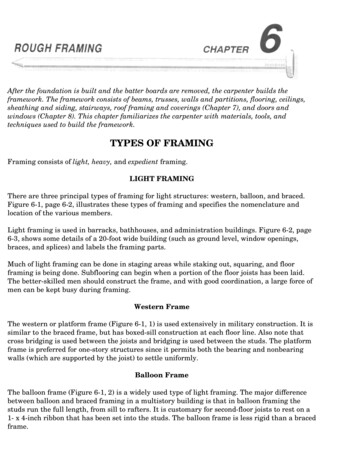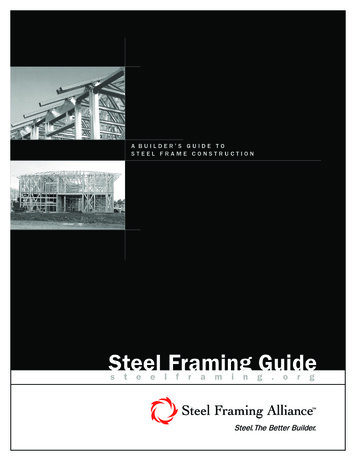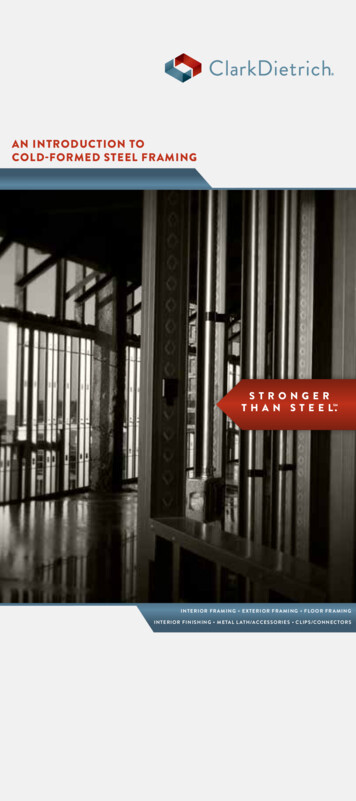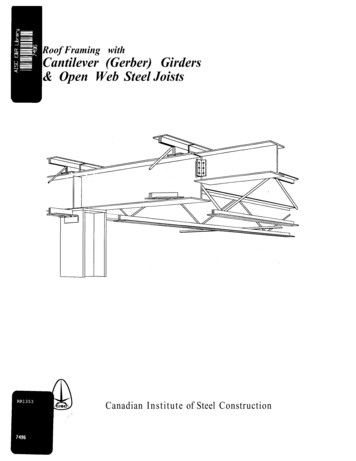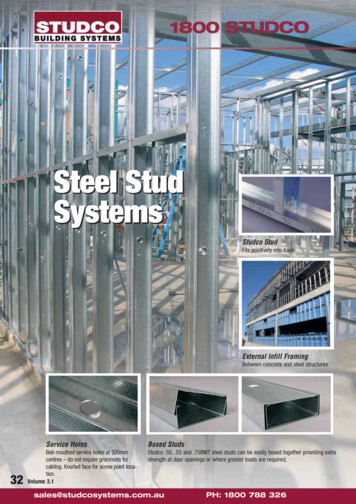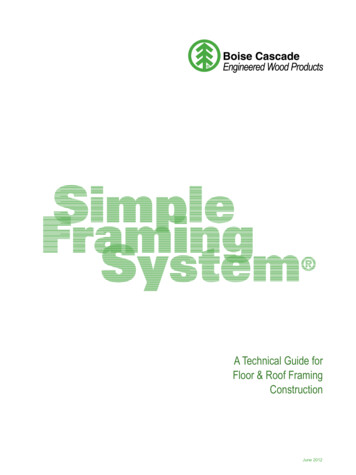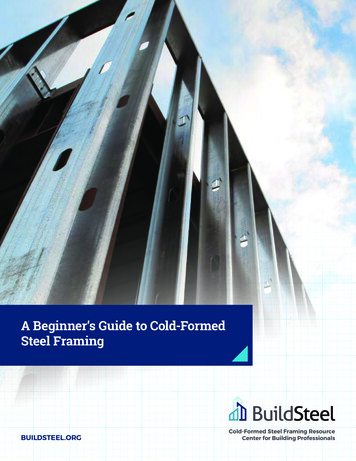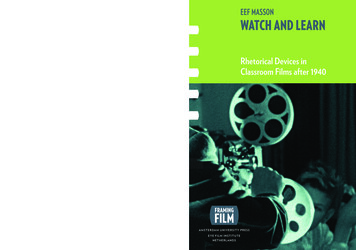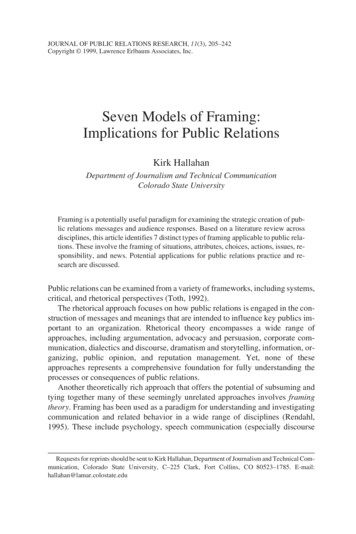
Transcription
SSMASteel Stud Manufacturers AssociationWWW.SSMA.COMCold-Formed Steel Details
ContentsCover Page . 1Contents . 2Disclaimer 4Window Details:Load Bearing, Back to Back Header, Single Jamb 5Load Bearing, Back to Back Header, Boxed Jamb 6Load Bearing, Back to Back Header, Back to Back Jamb 7Load Bearing, Boxed Header, Single Jamb 8Load Bearing, Boxed Header, Boxed Jamb 9Load Bearing, Boxed Header, Back to Back Jamb 10Load Bearing, Single Header with Strongback, Single Jamb . 11Load Bearing, Single Header with Strongback, Boxed Jamb . 12Load Bearing, Single Header with Strongback, Back to Back Jamb . 13Non-Load Bearing, Single Track Header, Single Jamb .14Non-Load Bearing, Single Track Header, Boxed Jamb . 15Non-Load Bearing, Single Track Header, Back to Back Jamb. 16Door Details:Load Bearing, Back to Back Header, Single Jamb 17Load Bearing, Back to Back Header, Boxed Jamb 18Load Bearing, Back to Back Header, Back to Back Jamb 19Load Bearing, Boxed Header, Single Jamb 20Load Bearing, Boxed Header, Boxed Jamb 21Load Bearing, Boxed Header, Back to Back Jamb 22Load Bearing, Single Header with Strongback, Single Jamb . 23Load Bearing, Single Header with Strongback, Boxed Jamb . 24Load Bearing, Single Header with Strongback, Back to Back Jamb . 25Non-Load Bearing, Single Track Header, Single Jamb .26Page 2
Non-Load Bearing, Single Track Header, Boxed Jamb . 27Non-Load Bearing, Single Track Header, Back to Back Jamb. 28Deflection Track Assembly:Single Track with Cold-rolled Channel . 29Double Deflection Track . 30BridgingSingle Flat Strap with Blocking . 31Double Flat Strap with Blocking .32Cold-rolled Channel with Angle Clip . 33Full-height Curtain Wall Deflection Clip .34Spandrel Curtain WallSticker to Beam 35Diagonal Brace .36Sticker with Vertical Drop and Diagonal Brace . 37Spandrel Framing at Pony Wall at Steel Post with Embed . 38Bottom Track AnchorageLow Velocity Fastener .39Wedge Anchor . 40BackingFlat Strap – Lightly Loaded 41Clipped Track – Heavily Loaded . 42Wall Framing at Corner – Track Lap Connection . 43Non-Load Bearing Interior WallFramed Above Ceiling with Diagonal Kicker . 44Framed to Ceiling with Diagonal Kicker . 45Shearwall X-Bracing . 46Typical Floor Framing 47Page 3
DISCLAIMERThe details contained in this document are intended as a general guide for using Steel StudManufacturers Association (SSMA) member products. These products should not be used in design orconstruction without an independent evaluation by a qualified engineer or architect to verify the suitabilityof a particular product for use in a specific application. The SSMA and its members assume no liabilityfor failure resulting from the use or misapplication of the detail drawings contained herein.This document may not be reproduced or distributed in any form, electronic or otherwise, without theexpress written consent of SSMA.In no event will SSMA be liable for any damages, including loss of data or information of any kind, lostprofits, cost of cover or any other special, incidental, consequential or indirect damages arising out ofthis agreement or the use or inability to use the details, however caused, and on any theory of liability.Warning:This electronic file is furnished without guarantee of compatibility with recipient’s hardware or softwareand may contain undetected viruses or other harmful material. It is recommended that the recipientcheck the electronic file prior to use. SSMA assumes no responsibility for damage to user’s property asa result of receiving and/or using the electronic file.Page 4
Window - Load BearingBack to Back HeaderSingle JambCRIPPLE STUDINFILL STUDHEADER TRACKSHEADERMEMBERSADVANTAGES:1. Use of cripple stud to receive head/sill tracks at thejamb studs helps maintain alignment of finishes.2.Back to back header reduces web-cripplingreinforcement requirements.3.Using a wider flange and thicker jamb stud materialreduces cost of installation compared to built-up jambstuds.4.Using a wider flange reduces possibility of installing awall stud as a jamb stud.JAMBANGLECRIPPLE STUDSILLINFILL STUDTYPICAL BASEANCHORAGEADDITIONALANCHORAGE@ JAMBBASE TRACKPage 5
Window - Load BearingBack to Back HeaderBoxed JambCRIPPLE STUDINFILL STUDHEADER TRACKSADVANTAGES:1. Use of cripple stud to receive head/sill tracks at thejamb studs helps maintain alignment of finishes.2.Back to back header reduces web-cripplingreinforcement requirements.3.Boxed jamb studs welded together reduces materialbuild-up and finish problems.HEADERMEMBERSJAMBANGLECRIPPLE STUDSILLINFILL STUDTYPICAL BASEANCHORAGEADDITIONALANCHORAGE@ JAMBBASE TRACKPage 6
Window - Load BearingBack to Back HeaderBack to Back JambCRIPPLE STUDINFILL STUDHEADER TRACKSHEADERMEMBERSTRACK PIECE@ OPEN SIDEADVANTAGES:1. Use of cripple stud to receive head/sill tracks at thejamb studs helps maintain alignment of finishes.Backto back header reduces web-crippling2.reinforcement requirements.3.Using a back to back jamb with a track cap piece at theopening eliminates welding so that thinner material canbe used depending on the load requirements.4.Reduces the need to reinforce the web at the endreactions of the jamb studs.JAMBANGLECRIPPLE STUDSILLINFILL STUDTYPICAL BASEANCHORAGEADDITIONALANCHORAGE@ JAMBBASE TRACKPage 7
Window - Load BearingBoxed HeaderSingle JambCRIPPLE STUDINFILL STUDHEADER TRACKSHEADERMEMBERSADVANTAGES:1. Use of cripple stud to receive head/sill tracks at thejamb studs helps maintain alignment of finishes.Boxedheader members provide backing for attachment2.of window covering support.3.Using a wider flange and thicker jamb stud materialreduces cost of installation compared to built-up jambstuds.4.Using a wider flange reduces possibility of installing awall stud as a jamb stud.JAMBANGLECRIPPLE STUDSILLINFILL STUDTYPICAL BASEANCHORAGEADDITIONALANCHORAGE@ JAMBBASE TRACKPage 8
Window - Load BearingBoxed HeaderBoxed JambCRIPPLE STUDINFILL STUDHEADER TRACKSHEADERMEMBERSADVANTAGES:1. Use of cripple stud to receive head/sill tracks at thejamb studs helps maintain alignment of finishes.Boxedjamb studs welded together reduces material2.build-up and finish problems.3.Boxed header members provide backing for attachmentof window covering support.JAMBANGLECRIPPLE STUDSILLINFILL STUDTYPICAL BASEANCHORAGEADDITIONALANCHORAGE@ JAMBBASE TRACKPage 9
Window - Load BearingBoxed HeaderBack to Back JambCRIPPLE STUDINFILL STUDHEADER TRACKSHEADERMEMBERSTRACK PIECE@ OPEN SIDEADVANTAGES:1. Use of cripple stud to receive head/sill tracks at thejamb studs helps maintain alignment of finishes.Boxedjamb studs welded together reduces material2.build-up and finish problems.3.Using a back to back jamb with a track cap piece at theopening eliminates welding so that thinner material canbe used depending on the load requirements.4.Reduces the need to reinforce the web at the endreactions of the jamb studs.JAMBANGLECRIPPLE STUDSILLINFILL STUDTYPICAL BASEANCHORAGEADDITIONALANCHORAGE@ JAMBBASE TRACKPage 10
Window - Load BearingSingle Header with StrongbackSingle JambINFILL STUDADVANTAGES:1. Use of cripple stud to receive head/sill tracks at the jambstuds helps maintain alignment of finishes.2. Strongback header minimizes number of members to beinstalled vs. back to back or boxed header.Usinga wider flange and thicker jamb stud material3.CRIPPLE STUDreduces cost of installation compared to built-up jambstuds.4.Using a wider flange reduces possibility of installing a wallstud as a jamb stud.Providesgood vertical load transfer at each strongback5.header into jamb stud.6.Reduces web-crippling reinforcement being required atend of strongback header.STRONGBACKJAMBHEADER TRACKCRIPPLE STUDSILLINFILL STUDTYPICAL BASEANCHORAGEADDITIONALANCHORAGE@ JAMBBASE TRACKPage 11
Window - Load BearingSingle Header with StrongbackBoxed JambINFILL STUDSTRONGBACKCRIPPLE STUDADVANTAGES:1.Use of cripple stud to receive head/sill tracks at the jambstuds helps maintain alignment of finishes.2.Strongback header minimizes number of members to beinstalled vs. back to back or boxed header.3.Boxed jamb studs welded together reduces materialbuild-up and finish problems.4.Provides good vertical load transfer at each strongbackheader into jamb stud.5.Reduces web-crippling reinforcement being required atend of strongback header.JAMBHEADER TRACKCRIPPLE STUDSILLINFILL STUDTYPICAL BASEANCHORAGEADDITIONALANCHORAGE@ JAMBBASE TRACKPage 12
Window - Load BearingSingle Header with StrongbackBack to Back JambINFILL STUDSTRONGBACKCRIPPLE STUDTRACK PIECE@ OPEN SIDEJAMBADVANTAGES:1.Use of cripple stud to receive head/sill tracks at the jambstuds helps maintain alignment of finishes.2.Strongback header minimizes number of members to beinstalled vs. back to back or boxed header.3.Using a back to back jamb with a track cap piece at theopening eliminates welding so that thinner material can beused depending on the load requirements.4.Reduces the need to reinforce the web at the endreactions of the jamb studs.5.Provides good vertical load transfer at each strongbackheader into jamb stud.6.Reduces web-crippling reinforcement being required atend of strongback header.HEADER TRACKCRIPPLE STUDSILLINFILL STUDTYPICAL BASEANCHORAGEADDITIONALANCHORAGE@ JAMBBASE TRACKPage 13
Window - Non-Load BearingSingle Track HeaderSingle JambCRIPPLE STUDINFILL STUDHEADER TRACKSADVANTAGES:1. Use of cripple stud to receive head/sill tracks at thejamb studs helps maintain alignment of finishes.2.Using a wider flange and thicker jamb stud materialreduces cost of installation compared to built-up jambstuds.3.Using a wider flange reduces possibility of installing awall stud as a jamb stud.JAMBCRIPPLE STUDSILLINFILL STUDADDITIONALANCHORAGE@ JAMBBASE TRACKPage 14
Window - Non-Load BearingSingle Track HeaderBoxed JambCRIPPLE STUDINFILL STUDADVANTAGES:1. Use of cripple stud to receive head/sill tracks at thejamb studs helps maintain alignment of finishes.2.Boxed jamb studs welded together reduces materialbuild-up and finish problems.HEADER TRACKSJAMBCRIPPLE STUDSILLINFILL STUDADDITIONALANCHORAGE@ JAMBBASE TRACKPage 15
Window - Non-Load BearingSingle Track HeaderBack to Back JambCRIPPLE STUDINFILL STUDHEADER TRACKSTRACK PIECEADVANTAGES:1.Use of cripple stud to receive head/sill tracks at thejamb studs helps maintain alignment of finishes.2.Using a back to back jamb with a track cap piece at theopening eliminates welding so that thinner material canbe used depending on the load requirements.3.Reduces the need to reinforce the web at the endreactions of the jamb studs.JAMBTRACK PIECECRIPPLE STUDSILLINFILL STUDADDITIONALANCHORAGE@ JAMBBASE TRACKPage 16
Door - Load BearingBack to Back HeaderSingle JambCRIPPLE STUDINFILL STUDHEADER TRACKSHEADERMEMBERSADVANTAGES:1. Use of cripple stud to receive head/sill tracks at thejamb studs helps maintain alignment of finishes.2.Back to back header reduces web-cripplingreinforcement requirements.3.Using a wider flange and thicker jamb stud materialreduces cost of installation compared to built-up jambstuds.4.Using a wider flange reduces possibility of installing awall stud as a jamb stud.JAMBANGLEADDITIONALANCHORAGE@ JAMBPage 17
Door - Load BearingBack to Back HeaderBoxed JambCRIPPLE STUDINFILL STUDHEADER TRACKSHEADERMEMBERSADVANTAGES:1. Use of cripple stud to receive head/sill tracks at jambstuds helps maintain alignment of finishes.2.Back to back header reduces web-cripplingreinforcement requirements.3.Boxed jamb studs welded together reduces materialbuild-up and finish problems.4.Provides better load transfer from jamb stud to basetrack vs. single jamb stud.JAMBANGLEANCHORAGEPage 18
Door - Load BearingBack to Back HeaderBack to Back JambCRIPPLE STUDINFILL STUDHEADER TRACKSHEADERMEMBERSTRACK PIECEJAMBADVANTAGES:1. Use of cripple stud to receive head/sill tracks at thejamb studs helps maintain alignment of finishes.2.Back to back header reduces web-cripplingreinforcement requirements.3.Using a back to back jamb with a track cap piece at theopening eliminates welding so that thinner material canbe used depending on the load requirements.4.Reduces the need to reinforce the web at the endreactions of the jamb studs.5.Provides better load transfer from jamb stud to basetrack vs. single jamb stud.ANGLEBASE TRACKADDITIONALANCHORAGE@ JAMBPage 19
Door - Load BearingBoxed HeaderSingle JambCRIPPLE STUDINFILL STUDHEADER TRACKSHEADERMEMBERSADVANTAGES:1. Use of cripple stud to receive head/sill tracks atthe jamb studs helps maintain alignment of finishes.2.Boxed header members provide backing forattachment of window covering support.3.Using a wider flange and thicker jamb stud materialreduces cost of installation compared to built-upjamb studs.4.Using a wider flange reduces possibility ofinstalling a wall stud as a jamb stud.JAMBANGLEADDITIONALANCHORAGE@ JAMBPage 20
Door - Load BearingBoxed HeaderBoxed JambCRIPPLE STUDINFILL STUDHEADER TRACKSHEADERMEMBERSADVANTAGES:1. Use of cripple stud to receive head/sill tracks atthe jamb studs helps maintain alignment of finishes.2.Boxed jamb studs welded together reducesmaterial build-up and finish problems.3.Boxed header members provide backing forattachment of window covering support.4.Provides better load transfer from jamb stud tobase track vs. single jamb stud.JAMBANGLEANCHORAGEPage 21
Door - Load BearingBoxed HeaderBack to Back JambCRIPPLE STUDINFILL STUDHEADER TRACKSHEADERMEMBERSTRACK PIECEJAMBADVANTAGES:1.Use of cripple stud to receive head/sill tracks at thejamb studs helps maintain alignment of finishes.2.Boxed jamb studs welded together reduces materialbuild-up and finish problems.3.Using a back to back jamb with a track cap piece at theopening eliminates welding so that thinner material canbe used depending on the load requirements.4.Reduces the need to reinforce the web at the endreactions of the jamb studs.5.Provides better load transfer from jamb stud to basetrack vs. single jamb stud.ANGLEBASE TRACKADDITIONALANCHORAGEPage 22
Door - Load BearingSingle Header with StrongbackSingle JambINFILL STUDSTRONGBACKCRIPPLE STUDJAMBADVANTAGES:1.Use of cripple stud to receive head/sill tracks at jambstuds helps maintain alignment of finishes.2.Strongback header minimizes number of members to beinstalled vs. back to back or boxed header.3.Using a wider flange and thicker jamb stud materialreduces cost of installation compared to built-up jambstuds.4.Using a wider flange reduces possibility of installing awall stud as a jamb stud.Providesgood vertical load transfer at each strongback5.header into jamb stud.6.Reduces web-crippling reinforcement being required atend of strongback header.HEADER TRACKADDITIONALANCHORAGE@ JAMBPage 23
Door - Load BearingSingle Header with StrongbackBoxed JambINFILL STUDSTRONGBACKCRIPPLE STUDADVANTAGES:1.Use of cripple stud to receive head/sill tracks at jambstuds helps maintain alignment of finishes.2.Strongback header minimizes number of members to beinstalled vs. back to back or boxed header.3.Boxed jamb studs welded together reduces materialbuild-up and finish problems.4.Provides good vertical load transfer at each strongbackheader into jamb stud.5.Reduces web-crippling reinforcement being required atend of strongback header.6.Provides better load transfer from jamb stud to basetrack vs. single jamb stud.JAMBHEADER TRACKANCHORAGEPage 24
Door - Load BearingSingle Header with StrongbackBack to Back JambINFILL STUDSTRONGBACKCRIPPLE STUDTRACK PIECEJAMBHEADER TRACKADVANTAGES:1.Use of cripple stud to receive head/sill tracks at jambstuds helps maintain alignment of finishes.2.Strongback header minimizes number of members to beinstalled vs. back to back or boxed header.3.Using a back to back jamb with a track cap piece at theopening eliminates welding so that thinner material can beused depending on the load requirements.4.Reduces the need to reinforce the web at the endreactions of the jamb studs.5.Provides good vertical load transfer at each strongbackheader into jamb stud.6.Reduces web-crippling reinforcement being required atend of strongback header.7.Provides better load transfer from jamb stud to basetrack vs. single jamb stud.BASE TRACKADDITIONALANCHORAGEPage 25
Door - Non-Load BearingSingle Track HeaderSingle JambCRIPPLE STUDINFILL STUDHEADER TRACKSADVANTAGES:1. Use of cripple stud to receive head/sill tracks atthe jamb studs helps maintain alignment of finishes.2.Using a wider flange and thicker jamb stud materialreduces cost of installation compared to built-upjamb studs.3.Using a wider flange reduces possibility of installinga wall stud as a jamb stud.JAMBADDITIONALANCHORAGE@ JAMBPage 26
Door - Non-Load BearingSingle Track HeaderBoxed JambINFILL STUDCRIPPLE STUDADVANTAGES:1. Use of cripple stud to receive head/sill tracks atthe jamb studs helps maintain alignment of finishes.2.Boxed jamb studs welded together reducesmaterial build-up and finish problems.3.Provides better load transfer from jamb stud tobase track vs. single jamb stud.HEADER TRACKSJAMBANCHORAGEPage 27
Door - Non-Load BearingSingle Track HeaderBack to Back JambCRIPPLE STUDINFILL STUDHEADER TRACKSTRACK PIECEADVANTAGES:1. Use of cripple stud to receive head/sill tracks at thejamb studs helps maintain alignment of finishes.2.Using a back to back jamb with a track cap piece at theopening eliminates welding so that thinner material canbe used depending on the load requirements.3.Reduces the need to reinforce the web at the endreactions of the jamb studs.4.Provides better load transfer from jamb stud to basetrack vs. single jamb stud.JAMBBASE TRACKADDITIONALANCHORAGEPage 28
Deflection Track AssemblySingle Track withCold-rolled ChannelADVANTAGES:1. Allows both vertical and horizontal movement ofthe structure above which supports the deflectiontrack.COLD-ROLLEDCHANNEL (CONT.)CLIP ANGLE[DEPTH 80% OFSTUD DEPTH (d)]SCREWATTACHMENTPage 29
GAP - TRACKLEG TO SCREWDEF'LGAPDeflection Track AssemblyDouble Deflection TrackSCREW ATTACHMENTSECTION A-AADVANTAGES:1. Provides lateral connection of the studs togetherwithout relying on cladding for lateral supportparallel to the wall.2. Allows both vertical and horizontal movement of thestructure above which supports the deflectiontrack.DEF'L TRACKTOP TRACKSTUDPage 30
BridgingSingle Flat StrapWith BlockingADVANTAGES:1. Good torsional resistance for studs of all depths.TRACK BLOCK PIECETO MATCH WALL STUDCLIP FLANGE AND BENDINSTALLO.C.FRAMED WALLFINISHSURFACESCREWATTACHMENTTAUT FLAT STRAPPage 31
BridgingDouble Flat StrapWith BlockingADVANTAGES:1. Provides good torsional restraint foraxially-loaded studs for all stud sizes.2. Strap layout is independent of punchoutlocation.TRACK BLOCK PIECETO MATCH WALL STUDCLIP FLANGE AND BENDINSTALLO.C.FRAMED WALLSCREW ATTACHMENTTAUT FLAT STRAPSPage 32
BridgingCold-rolled ChannelWith Clip AngleADVANTAGES:1. Ease of installation of cold-rolled channel throughpre-aligned stud punchouts.43 mil MIN.THICKNESSSCREWATTACHMENTCLIP ANGLE[LENGTH 80% OFSTUD DEPTH (d)]COLD-ROLLEDCHANNELPage 33
Full-height Curtain WallDeflection ClipSLIDE CLIPADVANTAGES:1. Allows floor/roof to move vertically without imparting anyaxial load to wall framing.2.Provides support for out-of-plane wind and seismic loadsand for in-plane seismic loads.3.Accommodates variation of slab edge to maintain wallalignment.STUDSTEEL WASHERSSCREWSLOTPage 34
Spandrel Curtain WallSticker to BeamADVANTAGES:1. Ease of installation.ANGLE CLIPSCREWATTACHMENTSTUDSTRUTSCREWATTACHMENTPage 35
Spandrel Curtain WallDiagonal BraceANGLE CLIPADVANTAGES:1. Ease of installation.2.Increases spacing between support points whichreduces lateral support reactions and TUDCLIP ANGLEKICKERMAX. 45 SCREWATTACHMENTPage 36
Spandrel Curtain WallSticker with Vertical DropAnd Diagonal BraceANGLE CLIPADVANTAGES:1. Increases spacing between support points whichreduces support reactions and decreases deflections.2. Transfers vertical load from the brace into bottom ofbeam rather than the wall.3.Allows support at floor/roof to be sized to take lateraland dead loads from wall only, rather than the NCHORAGECLIP ANGLEKICKERMAX. 45 SCREWATTACHMENTPage 37
Spandrel FramingAt Pony WallSteel Post with EmbedL.V.F.STUDTS SUPPORTPOSTADVANTAGES:1. Provides lateral support for pony wall with spandrelglass.2.Eliminates costly retrofitting.PL EMBEDFLUSH WITHCONCRETEFLOORBASE TRACKPage 38
Bottom Track AnchorageLow Velocity FastenerADVANTAGES:1. Economical to install vs. wedge anchor.STUDBASE TRACKLOW VELOCITY FASTENERPage 39
Bottom Track AnchorageWedge AnchorSTUDADVANTAGES:1. Edge clearance requirement is minimized.2.Good holding capacity allows fewer anchors to beinstalled.BASE TRACKWEDGE ANCHORPage 40
BackingFlat Strap - Lightly Loaded(Paper towel dispensers, towelbars, toilet paper holders)ADVANTAGES:1. Ease of installation.FRAMED WALL, SEEPLAN FOR SIZE &SPACINGFINISHSURFACESCREWATTACHMENTTAUT FLAT STRAPPage 41
BackingClipped Track - Heavily Loaded(Grab bars, handrails, wallhung cabinets)ADVANTAGES:1. Good load carrying capacity.STUDCONTINUOUS TRACKCLIP FLANGES AT EA. STUDSCREW ATTACHMENTPage 42
Wall Framing at CornerTrack Lap ConnectionSCREWATTACHMENTCLIP TRACK FLANGEAT LAP JOINTADVANTAGES:1. Provides good load transfer.2. Ties interior walls together.TRACKSTUDFINISHPage 43
Non-Load Bearing Interior WallFramed Above Ceiling withDiagonal KickerANCHORAGEKICKERADVANTAGES:1. Provides good load transfer from wall to kicker.2.Kicker does not place twisting load on wall top track.CLIP ANGLEMAX. 45 CEILING LINESCREWATTACHMENTSCREW ATTACHMENTSTUDPage 44
Non-Load Bearing Interior WallFramed to Ceiling withDiagonal KickerADVANTAGES:1. Eliminates extending wall above top of ceiling.SECTION A-AANCHORAGEDEEP LEG TRACKACLIP FLANGETO FORMSHOEACEILING LINEMAX. 45 SCREWATTACHMENTTOP TRACKSTUDPage 45
PER-TENSIONED STRAPS(EACH SIDE)TOP TRACKANCHORAGE(SIZED AND SPACEDTO TAKE THE SHEARLOAD FROM BRACE)Shearwall X-BracingADVANTAGES:1. Wide flat straps eliminate doubling the number of screwsif corner gussets are used.2. A thin flat strap reduces the material build-up that cancreate finish problems.HOLDOWNBASE TRACKSCREW ATTACHMENTANCHOR BOLTPage 46
Typical Floor FramingTRACK ORSTUD WEBSTIFFENERJOISTSCREWATTACHMENTADVANTAGES:1. Locating web stiffener on back side of web is easierto install than fitting the stiffener between joistflanges.2.Using screws to connect the web stiffeners is moreeconomical than using a series of weld segments.SCREWATTACHMENTJOISTTRACKSTUD (ALIGNEDWITH JOISTABOVE)Page 47
Cold-Formed Steel Details . Contents . These products should not be used in design or construction without an independent evaluation by a qualified engineer or architect to verify the suitability of a particular product for use in a specific
